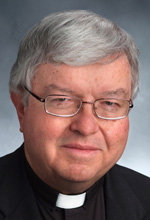Q. I have some questions regarding a practice I observed as a child (in the 1970s). While they were passing in front of a church (either walking or in a car), I used to notice some people making the sign of the cross. I’m not sure whether this was just a personal custom or one endorsed by the church. Are you familiar with this practice and, if so, how did it originate? Is it an appropriate sign of reverence? (Des Moines, Iowa)
A. Yes, I am familiar with this practice. I’m not sure whether it was taught to me by my mother or by the nuns in school. Ever since I was a child, whenever I pass a Catholic church I make the sign of the cross with my thumb on my forehead, as a priest does to a child at baptism.
I do this as a sign of reverence for Jesus, present in the tabernacle. I’m not aware of any official “endorsement” of this practice by the church, but such a gesture of faith is a long-standing custom — particularly in Ireland but also in Italy and the Philippines.
I know that some people when passing a church make the complete sign of the cross, employing the entire hand on the forehead, breast and both shoulders, but more often, it seems, just the thumb is used.
Interestingly, that simple cross on the forehead seems to have been the original sign used to indicate a Christian’s belief in the redemptive death and resurrection of Jesus, before it developed into the wider gesture.
[hotblock]
The theologian Tertullian, in the year 211 A.D., in a work called “The Chaplet,” wrote: “In all our actions, when we come in or go out, when we dress, when we wash, at our meals, before resting to sleep, we make on our forehead the sign of the cross. These practices are not commended to us by a formal law of Scripture, but tradition teaches them, custom confirms them and faith observes them.”
I also am aware of gentlemen tipping their hats when passing a church and of people making the sign of the cross when passing a cemetery (as a “quick prayer” for those buried there) or when an ambulance or fire engine goes by (asking God for a favorable outcome to that emergency).
Q. If a widow cannot marry a divorced man, why are local churches advertising CatholicMatch.com, which lists numerous divorced Catholic men looking for a wife? (Monmouth County, N.J.)
A. You’re right: A widow cannot marry a divorced man in a Catholic marriage — unless that man has had his earlier marriage annulled by the church. CatholicMatch.com is an online dating service that says its purpose is to “help single Catholics be in a better position to find their spouses and have successful marriages.”
Your question prompted me to contact CatholicMatch.com to ask whether, in fact, they were helping to find partners for those ineligible to marry with the church’s blessing. Their response quoted their published caution: “Please be aware that divorced members who are not free to marry in the Catholic Church are permitted to use CatholicMatch but not for romantic purposes. If this is your situation, we encourage you to contact your parish priest or diocesan marriage tribunal to determine if you are a candidate for the annulment process.”
To clarify even further, I emailed them back, asking what would be a “nonromantic” purpose for using a dating service, and they explained, “Divorced members who aren’t eligible to use the site for romantic purposes generally use the site as a ‘support system’ as they go through the annulment process.”
***
Questions may be sent to Father Kenneth Doyle at askfatherdoyle@gmail.com and 40 Hopewell St., Albany, N.Y. 12208.
PREVIOUS: Use Lent to shed apathy to sin, poverty, indifference to God, pope says
NEXT: ‘Monk’s mirror’ helps us pray the short, sharp Jesus Prayer




Share this story